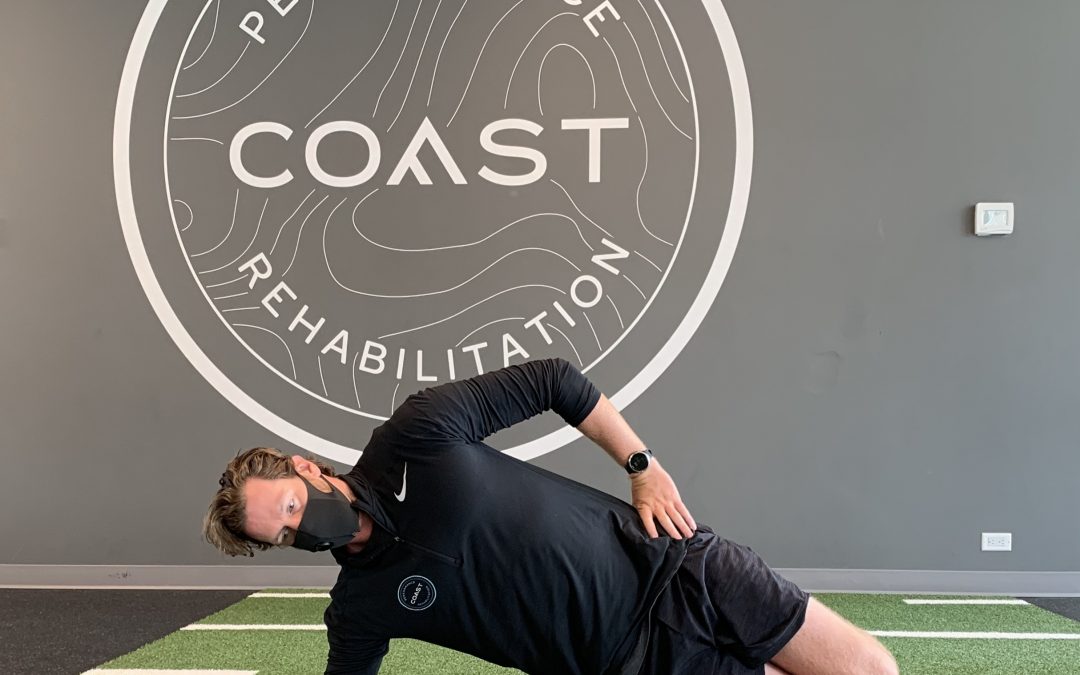By Coast Performance Rehab Clinic
Hip Strengthening for Runners
It is no surprise that runners are known for having weak hip muscles. Running is a constant forward motion and so little time is spent training with side-to-side movement. This means that significant muscle imbalances can occur, especially in the hips.
Strong hips can help runners increase power and speed, as well as reduce injuries by improving balance and muscular strength.
Here are four hip strengthening exercises to improve your running and ward off injuries:
Marching Hip Bridge
This is an intermediate bridge exercise that helps to strengthen the glutes as well as teaches you to keep the pelvis stabilized as the legs move.
- Start on your back with your feet on the ground and hip width apart.
- Press into your heels as you lift your pelvis up inline with your knees and you are in a basic bridge position.
- Keep your glutes engaged and lifted as you raise one leg towards your chest, creating a 90 degree angle and then slowly return the foot to the ground.
- Repeat on the other side.
- Really focus on keeping your hips lifted and your pelvis stable as you raise your leg.
- Continue to alternate legs for 12-15 reps.
If this exercise is too challenging, then opt for a regular glute bridge.
Side Plank Clam Shell
Clam shell exercises target the outer hip, specifically the glute medius. By combining a side plank with a clam shell, you are able to work your obliques and glute medius which helps to stabilize your hips while running.
- Start in a modified side plank with your knees bent and your elbow inline with your shoulder.
- Engage your core and glutes as you lift your hip off the ground.
- Hold the side plank position as you begin to open and close your top leg.
- Really focus on keeping your hips stacked and lifted by engaging your glutes.
Kickstand Romanian Deadlift
The Romanian Deadlift (RDL) trains the very important movement of hip hinging which is essential to low back health. The RDL differs from a standard deadlift and can be very effective at firing up the muscles along the posterior chain (i.e. back, glutes, hamstring) with less weight.
Form is everything with this exercise. Really focus on keeping your core engaged, back flat and moving from the hips by pushing them back.
- Start in a standing position with your feet hip width apart, weight in hand.
- Step one foot back with the forefoot lightly touching the ground. The majority of your weight should be on the front foot.
- Bend from the hips as you slowly lower the weight, keeping a slight bend in your knees.
- When you start to feel tension in your hamstring, engage your hamstrings and glutes as you drive your hips forward to come back up to a standing position.
- Repeat on the other leg.
Standing Banded Hip Flexor Marching
Weak hip flexors are a common issue with runners and, when combined with extended periods of time sitting in front of a desk, can be a recipe for injury. Your hip flexors are primarily responsible for moving your lower body and lifting your knee, such as when you take a running stride. This version on the Psoas March is from a standing position, mimicking a running motion.
- From a standing position, lean forward against a wall so that your body is at a slight angle.
- With a band around the soles of your feet, brace your core as you begin to lift your knee up, towards the wall.
- Slowly lower your leg down to the ground and then repeat on the other side.

